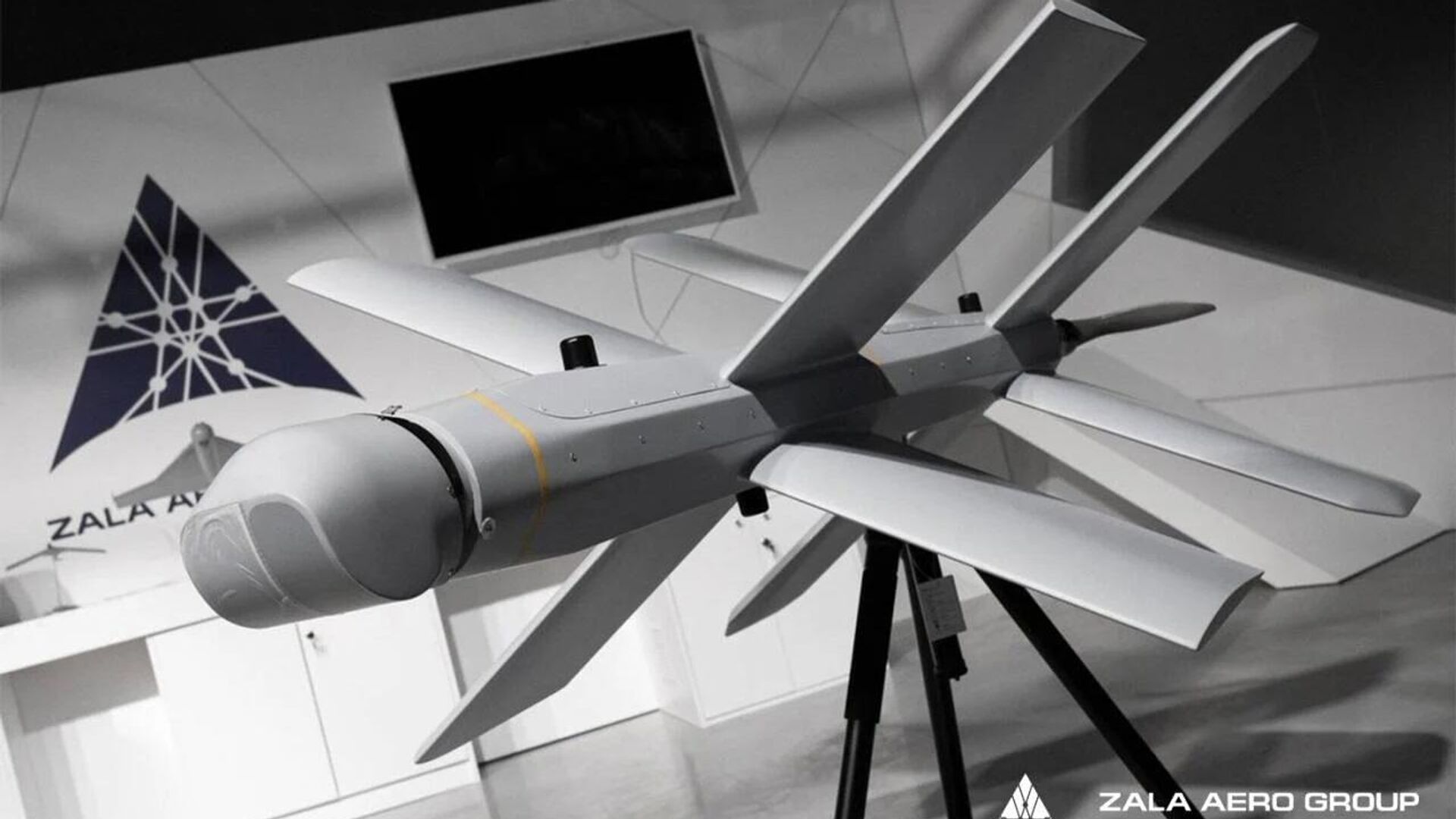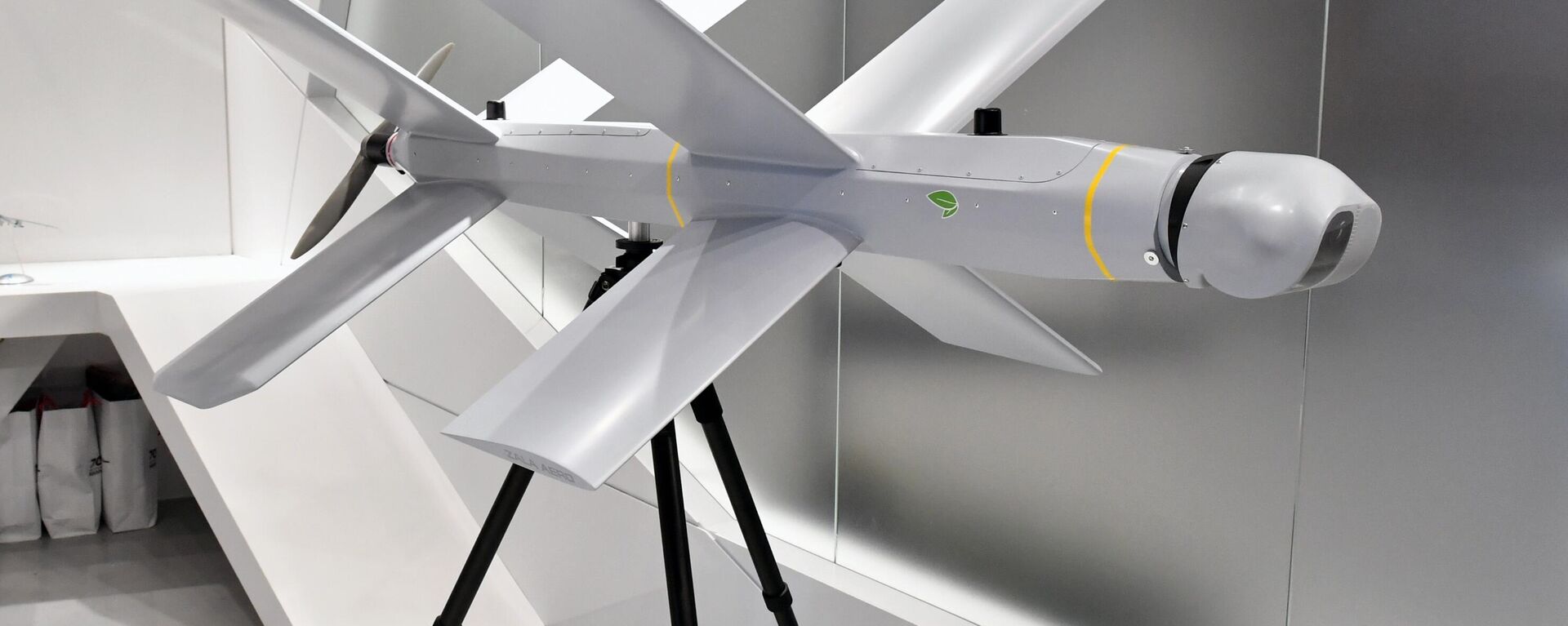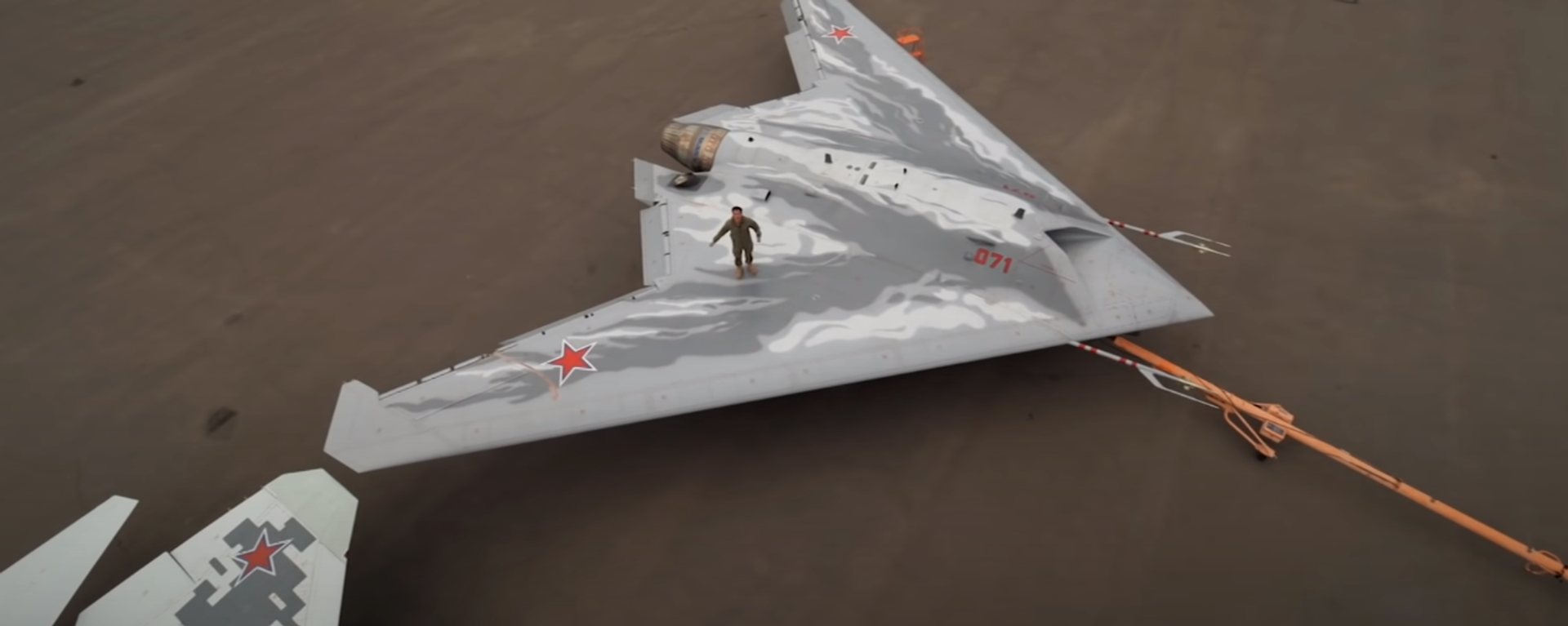https://sputnikglobe.com/20230515/what-is-the-lancet-kamikaze-drone-and-what-makes-it-so-deadly-1110378634.html
What is the Lancet Kamikaze Drone and What Makes It So Deadly?
What is the Lancet Kamikaze Drone and What Makes It So Deadly?
Sputnik International
The Lancet loitering munition/kamikaze drone has made the news in recent weeks as a game-changing piece of military hardware in the ongoing Russia-NATO proxy war in Ukraine. Who makes it? What are its characteristics? And have Ukrainian forces come to dread the unmanned aerial vehicle? Sputnik explores.
2023-05-15T12:40+0000
2023-05-15T12:40+0000
2023-05-15T13:25+0000
military
russia
ukraine
kiev
lancet
nato
rostec
s-300
drone
unmanned aerial vehicle
https://cdn1.img.sputnikglobe.com/img/07e7/05/0f/1110378131_0:74:1280:794_1920x0_80_0_0_dee92ecc9d7f5235019068ce001eb107.jpg
Recent weeks have seen a flurry of reports by the Russian military on the use of Lancet reconnaissance and strike UAVs against an array of Ukrainian and Western military hardware, with the drones targeting systems ranging from US-made M777 howitzers and Avenger air defense systems to Soviet Osa anti-aircraft missile systems and Czech-made RM-70 multiple rocket launchers.Last month, five Ukrainian air defense systems were destroyed over the course of a 24 hour period in the Kherson region, among them four Soviet-made S-300 anti-aircraft batteries and a German-sourced Gepard self-propelled anti-aircraft gun. Lancets were reportedly used to destroy all five.Lancets have subsequently gained a dreaded reputation as a game-changing weapon that takes away the advantage of Kiev’s NATO-provided shoot-and-scoot artillery – designed to quickly fire, pack up and relocate to another area to avoid Russian retaliatory fire. Defense observers say Russia's command, control, communications, computers, and intelligence (C4I) networks have learned to automatically target enemy artillery using the nearest Lancet drones immediately after launch, which can dramatically reduce scoot time.Not everyone in Ukraine is panicking. According to one report, a group of aviation enthusiasts has been collecting the remains of Lancet drones to turn them into key fobs and other knick-knacks and selling them on the internet.Who Makes Lancet Drones?Lancets were developed by ZALA Aero Group, an Izhevsk-based defense enterprise known for the production of drone and jammer systems for both military and civilian purposes. ZALA is a subsidiary of the Kalashnikov Concern, which is itself a subsidiary of Russian technology and defense giant Rostec.The Lancet, first previewed at the ARMY military expo in 2019, is the latest and most advanced of ZALA’s drone designs, with previously introduced UAVs including the large conventional wing design 421-20 and 421-09 reconnaissance drones, and small 421-04M, 421-08, 421-16 flying wing UAVs, also used for reconnaissance, and delivered to the military, but also civilian agencies such as Russia’s Ministry of Emergency Situations.The company also manufactures single and multi-rotor helicopters like the ZALA 421-02 and 421-06, made for aerial photography, delivery, as well as broadcast and retransmission of television and radio signals, with the latter designed to be able to operate in extreme Arctic conditions.The Lancet is also not the only loitering munition/kamikaze drone in ZALA’s arsenal, with the other being the Koub - a delta-wing strike drone with a payload of 3 kg, a maximum endurance time of 30 minutes, and a speed of 80-130 km per hour.What is the Lancet’s Maximum Range and Payload, and How Fast Can They Fly?The Lancet drone actually consists of two variants – the Lancet-3 and the Lancet-1. The Lancet-3 weighs 12 kg, has a maximum flight range of 40-70 km, an endurance time of 60 minutes, a cruising speed of 80-110 km per hour, a payload between 3 and 5 kg, and a unique, first-in-the-world system allowing it to accelerate to up to 300 km per hour while diving onto its aerial targets.The Lancet-1 is a miniaturized version of the drone with a takeoff weight of 5 kg, a 1 kg payload, a flight range of 40 km, and an endurance time of 30 minutes. The drones' onboard payload consists of high-explosive, HE-fragmentation, or thermobaric warheads –which detonate before contact to maximize damage.Lancets are recognizable by their distinct X-shaped wings, which are attached to an elongated fuselage and detachable camera-guidance head/nose. They are powered by a low-noise electric motor installed on the drone’s tail section, and can be catapult-launched from the ground or warships at sea.How Much Do Lancet Drones Cost?For reasons which should be obvious, ZALA has not revealed the price of its Lancet series drones, and until official information becomes available, figures circulating on the media will remain only guestimates.How Does the Lancet Compare to the US Switchblade Drone?The Lancet-3 has been compared to the Switchblade-600 drone, a US-made loitering munition used for over a decade by the American military in Iraq and Afghanistan, and sent to Ukraine among the tens of billions of dollars in Western military aid to Kiev.The Switchblade-600 has an endurance and range of up to 40 minutes and 40 km, respectively, a top speed of 185 km per hour, and a 4 kg tandem HEAT-fragmentation warhead, and a takeoff weight of 15 kg. It is operated manually via a satellite uplink, and has autonomous capabilities.Can Lancet Drones Be Jammed or Downed Using Electronic Warfare?Lancets are equipped with an optical-electronic guidance and TV guidance systems. Rostec says the drones have built-in anti-laser protection, which makes them "almost impossible to intercept and destroy." Drone specialists say the anti-laser protection could come from special materials used to make the UAVs, although the company has kept its properties under wraps.Ukrainian forces have been studying ways to suppress the drones using jamming in certain frequency ranges. However, this is reportedly only possible while the autonomous drones are under manual operator control.What Kinds of Targets Do Lancets Attack? Can They target Tanks?Lancets have been used to attack a variety of targets, ranging from enemy troops and light-armor to fortified artillery and mortar positions. They can also target enemy drones – with ZALA engineers creating a system they’ve dubbed "air mining" involving the presence of large number of Lancets in a particular area of the front to defend against enemy UAVs – with a focus on heavy attack drones.The system has proven effective against US and NATO-delivered artillery and air defenses and, according to OSINT analyses, has recorded hits against radar stations and systems used to control Ukraine’s Turkish-sourced Bayraktar TB2 drones, as well as tanks, trucks and armored personnel carriers.Does the Lancet Have Shortcomings?The Lancet has proven highly successful in Ukraine – with some Russian defense observers going so far as to characterize it as the most successful Russian drone design to date. But ZALA’s engineers won’t have an opportunity to rest on their laurels, as even today Kiev and its NATO patrons are undoubtedly working on ways to try to defeat the weapons. The drones’ known shortcomings include relatively low flight speed, short endurance time, and vulnerability to electronic warfare in certain frequency ranges (as mentioned above).ZALA has demonstrated its continued work to improve the Lancet, introducing upgraded Lancet-3M UAVs last summer featuring larger payloads, and higher endurance, as well as modifications to its X wings – from two symmetrical Xs to one larger one and one smaller one to improve the UAV’s aerodynamic properties.
https://sputnikglobe.com/20230507/russian-drone-lancet-destroys-us-avenger-in-special-operation-zone---defense-ministry-1110163967.html
https://sputnikglobe.com/20230510/drone-attack-on-military-object-repelled-in-russias-voronezh-region-1110234270.html
https://sputnikglobe.com/20230424/russia-brings-focus-on-development-of-military-drones-electronic-warfare-1109782683.html
https://sputnikglobe.com/20230514/us-pressure-on-kiev-to-deliver-battlefield-success-could-botch-counteroffensive-1110333858.html
russia
ukraine
kiev
Sputnik International
feedback@sputniknews.com
+74956456601
MIA „Rossiya Segodnya“
2023
News
en_EN
Sputnik International
feedback@sputniknews.com
+74956456601
MIA „Rossiya Segodnya“
Sputnik International
feedback@sputniknews.com
+74956456601
MIA „Rossiya Segodnya“
drone, lancet drone, unmanned aerial vehicle, uav, drone warfare, lancet kamikaze drone, lancet drone, lancet kamikaze drones, russian lancet, russian lancet drone, lancet kamikaze drone price, lancet drone range, zala lancet, lancet-1 drone, zala lancet drone, kamikaze drones
drone, lancet drone, unmanned aerial vehicle, uav, drone warfare, lancet kamikaze drone, lancet drone, lancet kamikaze drones, russian lancet, russian lancet drone, lancet kamikaze drone price, lancet drone range, zala lancet, lancet-1 drone, zala lancet drone, kamikaze drones
What is the Lancet Kamikaze Drone and What Makes It So Deadly?
12:40 GMT 15.05.2023 (Updated: 13:25 GMT 15.05.2023) The Lancet loitering munition/kamikaze drone has made the news in recent weeks as a game-changing piece of military hardware in the ongoing Russia-NATO proxy war in Ukraine. Who makes it? What are its characteristics? And have Ukrainian forces come to dread the unmanned aerial vehicle? Sputnik explores.
Recent weeks have seen a flurry of reports by the Russian military on the use of Lancet reconnaissance and strike UAVs against an array of Ukrainian and Western military hardware, with the drones targeting systems ranging from US-made M777
howitzers and
Avenger air defense systems to Soviet Osa anti-aircraft missile systems and Czech-made
RM-70 multiple rocket launchers.
Last month, five Ukrainian air defense systems were destroyed over the course of a
24 hour period in the Kherson region, among them four Soviet-made S-300 anti-aircraft batteries and a German-sourced Gepard self-propelled anti-aircraft gun. Lancets were reportedly used to destroy all five.
Lancets have subsequently gained a dreaded reputation as a game-changing weapon that takes away the advantage of Kiev’s NATO-provided
shoot-and-scoot artillery – designed to quickly fire, pack up and relocate to another area to avoid Russian retaliatory fire. Defense observers
say Russia's command, control, communications, computers, and intelligence (C4I) networks have learned to automatically target enemy artillery using the nearest Lancet drones immediately after launch, which can dramatically reduce scoot time.
Not everyone in Ukraine is panicking. According to one report, a group of aviation enthusiasts has been
collecting the remains of Lancet drones to turn them into key fobs and other knick-knacks and selling them on the internet.
Lancets were developed by ZALA Aero Group, an Izhevsk-based defense enterprise known for the production of drone and jammer systems for both military and civilian purposes. ZALA is a subsidiary of the Kalashnikov Concern, which is itself a subsidiary of Russian technology and defense giant Rostec.
The Lancet, first previewed at the ARMY military expo in 2019, is the latest and most advanced of ZALA’s drone designs, with previously introduced UAVs including the large conventional wing design 421-20 and 421-09 reconnaissance drones, and small 421-04M, 421-08, 421-16 flying wing UAVs, also used for reconnaissance, and delivered to the military, but also civilian agencies such as Russia’s Ministry of Emergency Situations.
The company also manufactures single and multi-rotor helicopters like the ZALA 421-02 and 421-06, made for aerial photography, delivery, as well as broadcast and retransmission of television and radio signals, with the latter designed to be able to operate in extreme Arctic conditions.
The Lancet is also not the only loitering munition/kamikaze drone in ZALA’s arsenal, with the other being the Koub - a delta-wing strike drone with a payload of 3 kg, a maximum endurance time of 30 minutes, and a speed of 80-130 km per hour.
What is the Lancet’s Maximum Range and Payload, and How Fast Can They Fly?
The Lancet drone actually consists of two variants – the Lancet-3 and the Lancet-1. The Lancet-3 weighs 12 kg, has a maximum flight range of 40-70 km, an endurance time of 60 minutes, a cruising speed of 80-110 km per hour, a payload between 3 and 5 kg, and a unique, first-in-the-world system allowing it to accelerate to up to 300 km per hour while diving onto its aerial targets.
The Lancet-1 is a miniaturized version of the drone with a takeoff weight of 5 kg, a 1 kg payload, a flight range of 40 km, and an endurance time of 30 minutes. The drones' onboard payload consists of high-explosive, HE-fragmentation, or thermobaric warheads –which detonate before contact to maximize damage.
Lancets are recognizable by their distinct X-shaped wings, which are attached to an elongated fuselage and detachable camera-guidance head/nose. They are powered by a low-noise electric motor installed on the drone’s tail section, and can be catapult-launched from the ground or warships at sea.
How Much Do Lancet Drones Cost?
For reasons which should be obvious, ZALA has not revealed the price of its Lancet series drones, and until official information becomes available, figures circulating on the media will remain only guestimates.
How Does the Lancet Compare to the US Switchblade Drone?
The Lancet-3 has been compared to the Switchblade-600 drone, a US-made loitering munition used for over a decade by the American military in Iraq and Afghanistan, and sent to Ukraine among the tens of billions of dollars in Western military aid to Kiev.
The Switchblade-600 has an endurance and range of up to 40 minutes and 40 km, respectively, a top speed of 185 km per hour, and a 4 kg tandem HEAT-fragmentation warhead, and a takeoff weight of 15 kg. It is operated manually via a satellite uplink, and has autonomous capabilities.
Can Lancet Drones Be Jammed or Downed Using Electronic Warfare?
Lancets are equipped with an optical-electronic guidance and TV guidance systems. Rostec
says the drones have built-in anti-laser protection, which makes them "almost impossible to intercept and destroy." Drone specialists say the anti-laser protection
could come from special materials used to make the UAVs, although the company has kept its properties under wraps.
Ukrainian forces have been
studying ways to suppress the drones using jamming in certain frequency ranges. However, this is reportedly only possible while the autonomous drones are under manual operator control.
What Kinds of Targets Do Lancets Attack? Can They target Tanks?
Lancets have been used to attack a variety of targets, ranging from enemy troops and light-armor to fortified artillery and mortar positions. They can also target enemy drones – with ZALA engineers creating a system they’ve dubbed "air mining" involving the presence of large number of Lancets in a particular area of the front to defend against enemy UAVs – with a focus on heavy attack drones.
The system has proven effective against US and NATO-delivered artillery and air defenses and,
according to OSINT analyses, has recorded hits against radar stations and systems used to control Ukraine’s Turkish-sourced Bayraktar TB2 drones, as well as tanks, trucks and armored personnel carriers.
Does the Lancet Have Shortcomings?
The Lancet has proven highly successful in Ukraine – with some Russian defense observers going so far as to characterize it as the most successful Russian drone design to date. But ZALA’s engineers won’t have an opportunity to rest on their laurels, as even today Kiev and its NATO patrons are undoubtedly
working on ways to try to defeat the weapons. The drones’ known shortcomings include relatively low flight speed, short endurance time, and vulnerability to electronic warfare in certain frequency ranges (as mentioned above).
ZALA has demonstrated its continued work to improve the Lancet, introducing upgraded Lancet-3M UAVs last summer featuring larger payloads, and higher endurance, as well as
modifications to its X wings – from two symmetrical Xs to one larger one and one smaller one to improve the UAV’s aerodynamic properties.






